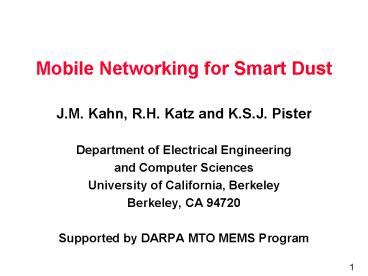Mobile Networking for Smart Dust
1 / 21
Title: Mobile Networking for Smart Dust
1
Mobile Networking for Smart Dust
- J.M. Kahn, R.H. Katz and K.S.J. Pister
- Department of Electrical Engineering
- and Computer Sciences
- University of California, Berkeley
- Berkeley, CA 94720
- Supported by DARPA MTO MEMS Program
2
Outline
- Smart Dust
- What is it?
- Applications
- Power Management
- Delivery and Interrogation
- Smart Dust Networking
- Radio-frequency communication
- Optical communication passive dust mote
transmitters - Optical communication active dust mote
transmitters - Summary
3
Smart Dust
- A dust mote is an autonomous node incorporating
sensing, computing, communications and a power
source in a mm3 volume - A collection of dust motes is dispersed
throughout an environment - Dust motes use wireless communication to relay
information to a base station over distances of
10s to 1000s of m
4
Smart Dust Mote
5
Applications of Smart Dust
- Civilian
- Surveillance
- Meteorological or geophysical monitoring
- Non-invasive measurement
- Measurement in hostile environments
- Military
- Stealthy monitoring of hostile environments
- Perimeter surveillance
- Chemical or biological monitoring
- Identification of friend or foe
6
Power Management
- Sources
- Solar cells
- Thermopiles
- Storage
- Batteries 1 J/mm3
- Capacitors 1 mJ/mm3
- Usage
- Digital control nW
- Analog circuitry nJ/sample
- Communication nJ/bit
7
Delivery and Interrogation
- Delivery Systems
- Manual
- Micro air vehicle
- Projectile
- Wind-borne (maple seeds)
- Interrogation
- Hand-held binoculars
- Micro air vehicle
MAV built by MLB Co.
8
Radio-Frequency Communications
- Pros
- Long range
- Line-of-sight path not required
- Not severely affected by rain, fog or atmospheric
turbulence - Cons
- Antenna may be too large for dust motes
- Requires modulator, demodulator, filtering (power
consumption) - Requires complex multiplexing scheme (TDMA, FDMA,
CDMA)
9
Corner-Cube Retroreflector
- Fabricate CCR using MEMS technology.
- Light striking within about 30 of body diagonal
undergoes 3 bounces and returns to source in a
narrow beam (ltlt 1). - Can deflect one mirror electrostatically,
modulating return beam at up to 10 kbps. - Dust mote can transmit passively without
radiating energy and without aiming beam.
10
First-Generation Dust Mote
11
Optical Communication UsingPassive Dust Mote
Transmitters
12
Optical Communication UsingPassive Dust Mote
Transmitters (cont.)
- Requires each dust mote to have a line-of-sight
path to the base station. - Uplink transmissions are multiplexed using
space-division multiplexing.
13
Optical Communication UsingPassive Dust Mote
Transmitters (cont.)
- Protocol
- Dust motes are asleep.
- Base station broadcasts a wakeup/query, then a
periodic interrogating signal synchronized to its
camera. - Dust motes wake up, transmit simultaneously to
base station, synchronized to its camera. - Reliability
- Dust mote positions and orientations are random,
and some are not in field-of-view of base
station. To insure coverage, use an excess of
dust motes. - Base station is only single point of failure.
14
Optical Communication UsingPassive Dust Mote
Transmitters (cont.)
- Pros
- Dust motes need not radiate power, nor steer beam
- Exploits asymmetry powerful base station,
low-power dust motes - Utilizes space-division multiplexing
- Only baseband electronics are required
- Cons
- Requires line-of-sight path to base station
- Short range (up to about 1 km)
- Bit rate limited to about 10 kbps
- Affected by rain, fog, atmospheric turbulence
15
Active Dust Mote Transmitter
Two-axis beam steering assembly
Active dust mote transmitter
- Beams should have divergence ltlt 1º and be
steerable over a hemisphere.
16
Optical Communication UsingActive Dust Mote
Transmitters
- Base station uses CCD or CMOS camera (up to 1
Mbps) - Using multi-hop routing, not all dust motes need
to have a line-of-sight path to the base station.
17
Optical Communication UsingActive Dust Mote
Transmitters (cont.)
- Minimizing transmitted energy/bit
- Dust mote should transmit in short bursts at high
bit rate - Link Acquisition
- Need protocols for dust motes to aim their
directional transmitters at other nodes - Dust motes should execute raster scan using a
narrow (not wide) beam
18
Optical Communication UsingActive Dust Mote
Transmitters (cont.)
- Link Non-Reciprocity
- Arises because dust motes use directional
transmitters but non-directional receivers - May cause a dust mote to waste power transmitting
to nodes unable to receive from it. A dust mote
should transmit only to nodes that acknowledge
its transmissions. - May cause collisions at dust motes during
mote-to-mote communications. - Routing
- How to acquire, propagate and update routing
information?
19
Optical Communication UsingActive Dust Mote
Transmitters (cont.)
- Pros
- Longer range than passive links (up to about 10
km) - Higher bit rates than passive links (up to about
1 Mbps) - With multi-hop, avoids need for every dust mote
to have line-of-sight path to base station - Utilizes space-division multiplexing
- Only baseband electronics are required
- Cons
- Requires protocol to steer directional
transmitters - Requires higher power than passive transmitter
- Affected by rain, fog, atmospheric turbulence
20
Atmospheric Turbulence
- Enhancing signal detection reliability
- Adaptive optics on imaging receiver
- Spatial receiver diversity (multiple receivers)
- Temporal receiver diversity
- Maximum-likelihood sequence detection based on
Markov model of scintillation process - Interleaving and forward error correction
21
Summary
- Smart dust motes incorporate sensing,
computation, communications and power in a mm3
volume. - Free-space optical communication offers
advantages in terms of size, power and network
throughput. - Passive dust mote optical transmitters
- Use corner-cube retroreflector
- Consume very little power
- Require line-of-sight path to base station
- Active dust mote optical transmitters
- Use laser and beam-steering mirror
- Enable higher bit rates, longer ranges, multi-hop
routing































